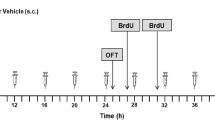Abstract
By studying the hibernation in ground squirrels, a protein factor termed hibernation induction trigger (HIT) was found to induce hibernation in summer-active ground squirrels. Further purification of HIT yielded an 88-kD peptide that is enriched in winter hibernator. Partial sequence of the 88-kD protein indicates that it may be related to the inhibitor of metalloproteinase. Delta opioid [D-Ala2,D-Leu5]enkephalin (DADLE) also induced hibernation. HIT and DADLE were found to prolong survival of peripheral organs preserved en bloc or as a single preparation. These organs include the lung, the heart, liver and kidney. DADLE also promotes survival of neurons in the central nervous system. Methamphetamine (METH) is known to cause destruction of dopaminergic (DA) terminals in the brain. DADLE blocked and reversed the DA terminal damage induced by METH. DADLE acted against this effect of METH at least in part by attenuating the mRNA expressions of a tumor necrosis factor p53 and an immediate early gene c-fos. DADLE also blocked the neuronal damage induced by ischemia-reperfusion following a transient middle cerebral artery occlusion. In PC12 cells, DADLE blocked the cell death caused by serum deprivation in a naltrexone-sensitive manner. Thus, DADLE, and by extension the endogenous delta opioid peptides and delta opioid receptors, may play an important role in organ and neuronal survival. Here, critical developments concerning these fascinating cell protective properties of DADLE are reviewed.
Similar content being viewed by others
References
Bell JA, Su T-P, Wang Y, Borlongan CV. Delta opioid peptide (DADLE) improves dopaminergic cell graft viability and functional effects and protects against 6-OHDA neurotoxicity. Soc Neurosci Abstr 25:1339;1999.
Bolling SF, Su T-P, Childs KF, Ning XH, Horton N, Kilgore K, Oeltgen PR. The use of hibernation induction triggers for cardiac transplant preservation. Transplantation 63:326–329;1997.
Bolling SF, Tramontini NL, Kilgore K, Su T-P, Oeltgen PR, Harlow HH. The use of ‘natural’ hibernation induction triggers for myocardial protection. Ann Thorac Surg 64:623–627;1997.
Bolling SF, Benedict MB, Tramontini NL, Kilgore KS, Harlow HH, Su T-P, Oeltgen PR. Hibernation triggers and myocardial protection. Circulation 98:II220–224;1998.
Borlongan CV, Oeltgen PR, Su T-P, Wang Y. Delta opioid peptide (DADLE) protects against ischemia-reperfusion damage in the striatum and cerebral cortex. Soc Neurosci Abstr 24:979;1999.
Borlongan CV, Wu JN, Su T-P, Wang Y. Delta opioid peptide (DADLE) enhances survival of cultured fetal cells. Committee on Problems of Drug Dependence 61st Meeting Abstr 13;1999.
Bruce DS, Cope GW, Elam TR, Ruit SK, Oeltgen PR, Su T-P. Opioids and hibernation. I. Effects of naloxone on bear HIT's depression of guinea-pig ileum contractility and on induction of summer hibernation in the ground squirrel. Life Sci 41:2107–2113;1987.
Cantanese JJ, Kress LF. Isolation from opossum serum of a metalloproteinase inhibitor homologous to human alpha 1-B-glycoprotein. Biochemistry 31:410–418;1992.
Chien S, Oeltgen PR, Diana JN, Shi X, Nilekani SP, Salley RK. Two-day preservation of major organs with autoperfusion and hibernation induction trigger. J Thorac Cardiovasc Surg 102:224–234;1991.
Chien S, Oeltgen PR, Diana JN, Salley RK, Su T-P. Extension of tissue survival time in multiorgan block preparation using a delta opioid DADLE. J Thorac Cardiovasc Surg 107:964–967;1994.
Dawe AR, Spurrier WA. Hibernation induced in ground squirrels by blood transfusion. Science 163:298–299;1969.
Hayashi T, Hirata H, Asanuma M, Tsao L-I, Su T-P, Cadet JL. Induction of p53 mRNA by methamphetamine (METH) is blocked by DADLE via nonopioid action: Potential mechanism underlying the protective effect of DADLE against METH-induced neurotoxicity. Soc Neurosci Abstr 24:1243;1998.
Hayashi T, Tsao T-L, Cadet JL, Su T-P. [D-Ala2-D-Leu5]enkephalin blocks the methamphetamine-induced c-fos mRNA increase in mouse striatum. Eur J Pharmacol 366:R7-R8;1999.
Horton ND, Kaftani DJ, Bruce DS, Bailey EC, Krober AS, Jones JR, Turker M, Khattar N, Su T-P, Bolling SF, Oeltgen PR. Isolation and partial characterization of an opioid-like 88 kDa hibernation-related protein. Comp Biochem Physiol 119:787–805;1998.
Ishioka N, Takahashi N, Putnam FW. Amino acid sequence of human plasma alpha1-B-glycoprotein: Homology to the immunoglobulin supergene family. Proc Natl Acad Sci USA 83:2363–2367;1986.
Mayfield KP, D'Alecy LG. Delta-1 opioid receptor dependence of acute hypoxic adaptation. J Pharmacol Exp Ther 268:74–77;1994.
Oeltgen PR, Welborn JR, Nuchols PA, Spurrier WA, Bruce DS, Su T-P. Opioids and hibernation. II. Effects of kappa opioid U69593 on induction of hibernation in summer-active ground squirrels by ‘hibernation induction trigger’ (HIT). Life Sci 41:2115–2120;1987.
Oeltgen PR, Nilekani SP, Nuchols PA, Spurrier WA, Su T-P. Further studies on opioid and hibernation: Delta opioid receptor ligand selectively induced hibernation in summer-active ground squirrels. Life Sci 43:1565–1574;1988.
Oeltgen PR, Horton ND, Bolling SF, Su T-P. Extended lung preservation with the use of hibernation trigger factors. Ann Thorac Surg 61:1448–1493;1996.
Schultz J el-J, Hsu AK, Nagase H, Gross GJ. TAN-67, a delta 1-opioid receptor agonist, reduces infarct size via activation of Gi/o proteins and KATP channels. Am J Physiol 274:H909-H914;1998.
Su T-P, Hayashi T. Delta opioid peptide DADLE attenuates neuronal death caused by serum or trophic factor deprivation in pheochromocytoma (PC12) cells via an opioid receptor dependent mechanism. Soc Neurosci Abstr 25:550;1999.
Tsao L-I, Ladenheim B, Andrews A, Chiueh CC, Cadet JL, Su T-P. Delta opioid peptide [D-Ala2,D-Leu5]enkephalin blocks the long-term loss of dopamine transporter induced by multiple administrations of methamphetamine: Involvement of opioid receptors and reactive oxygen species. J Pharmacol Exp Ther 287:322–331;1998.
Tsao L-I, Cadet JL, Su T-P. Reversal by [D-Ala2-D-Leu5]enkephalin of dopamin transporter loss caused by methamphetamine. Eur J Pharmacol 372:R5-R7;1999.
Wu G, Zhang F, Salley RK, Diana JN, Su T-P, Chien SF. Delta opioid extends hypothermic preservation time of the lung. J Thorac Cardiovasc Surg 111:259–267;1996.
Yin D, Mufson RA, Wang R, Shi Y. Fasmediated cell death promoted by opioids. Nature 397:218;1999.
Author information
Authors and Affiliations
Rights and permissions
About this article
Cite this article
Su, TP. Delta opioid peptide [D-Ala2,D-Leu5]enkephalin promotes cell survival. J Biomed Sci 7, 195–199 (2000). https://doi.org/10.1007/BF02255466
Issue Date:
DOI: https://doi.org/10.1007/BF02255466



